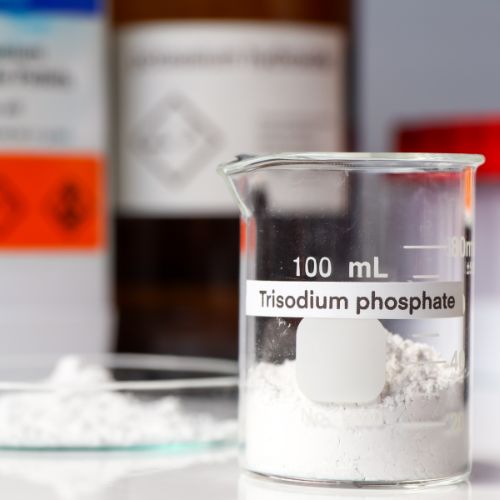Table of Contents
Trisodium Phosphate (TSP) has long been recognized as a robust cleaner, capable of tackling some of the most challenging stains and dirt accumulations around the home. Whether it’s for prepping surfaces for a fresh coat of paint or cleaning up after a major renovation, TSP’s effectiveness is unmatched. However, its power comes with responsibilities regarding safety and environmental concerns. This guide dives deeper into the world of TSP, providing you with a more detailed understanding and practical advice on utilizing this potent cleaner effectively and safely.
Understanding Trisodium Phosphate
TSP is a chemical compound consisting mainly of sodium phosphate, which, when mixed with water, creates an alkaline solution with formidable cleaning power. It’s particularly effective as a degreaser, stain remover, and a preparatory agent for painting surfaces.
Where TSP Shines
- Heavy-Duty Cleaning: Ideal for removing grease, grime, and soot from surfaces like masonry, wood decking, and siding.
- Paint Preparation: Strips away old paint, deglosses surfaces, and ensures new paint adheres properly.
- Mold and Mildew Removal: When mixed with bleach, it can tackle mold and mildew, making it essential for bathroom and kitchen cleanup.
The Downsides and Risks
While TSP’s cleaning prowess is significant, it’s not without its drawbacks:
- Toxicity: TSP poses risks if ingested, and its dust or solution can irritate the skin and eyes. Proper safety gear, such as goggles, gloves, and protective clothing, is non-negotiable.
- Environmental Impact: Phosphates from TSP can contribute to algae blooms in water bodies, disrupting ecosystems. Its use is regulated or banned in certain areas due to these concerns.
- Potential Damage: Its high alkalinity means TSP can damage certain surfaces, including glass, metals, and painted woods. Always test on a small area first.
Best Practices for Using Trisodium Phosphate
Safety First
- Personal Protection: Wear PPE, including goggles, gloves, and long-sleeved clothing.
- Ventilation: Work in well-ventilated areas to avoid inhaling dust or fumes.
Application Tips
- Mixing: Follow the recommended ratios, adjusting the concentration based on the cleaning task.
- Rinsing: Thoroughly rinse cleaned surfaces to prevent residue that can affect pets, plants, or future paint applications.
- Environmental Precautions: Avoid using near waterways, and be mindful of runoff that could affect local flora.
Storage and Disposal
- Storage: Keep TSP in a dry, secure place to prevent clumping and accidental exposure.
- Disposal: Dispose of any unused solution responsibly, following local regulations regarding chemical waste.
Alternatives to Trisodium Phosphate
Given the environmental and safety concerns associated with TSP, many seek less harmful alternatives. These alternatives may not match TSP’s strength but offer a safer, eco-friendly option for many cleaning tasks:
- Sodium Sesquicarbonate: A phosphate-free TSP substitute that’s less impactful on the environment.
- Borax (Sodium Borate): A natural mineral that serves as a versatile cleaner, though less potent against grease.
- Dawn Dish Soap: Effective for cutting through surface grease without the harsh chemicals.
- Pressure Washing: For exterior cleaning, pressure washing can remove dirt and mildew without chemicals.
Cleaning with TSP: A Step-by-Step Guide
- Preparation: Gear up with your PPE and prepare the area by covering sensitive surfaces.
- Mixing the Solution: Dissolve the appropriate amount of TSP in hot water, following the guidelines for the specific cleaning task.
- Application: Apply the solution using a sponge or scrub brush, working from bottom to top to prevent streaking.
- Rinsing: Rinse the area thoroughly with water to remove all traces of TSP, which might leave a residue if not properly cleaned off.

Conclusion
Trisodium Phosphate is a powerful tool in the cleaning arsenal for those tough jobs where ordinary cleaners just won’t cut it. However, its use requires careful consideration of safety procedures, environmental impacts, and the potential for damage to certain materials. By following best practices and considering alternatives when appropriate, you can harness the cleaning power of TSP effectively and responsibly, ensuring your projects are not only clean but also green.
Remember, the goal is not just to clean but to do so in a way that’s safe for you, your home, and the environment. With the right knowledge and precautions, TSP can be a valuable asset for your toughest cleaning challenges.



